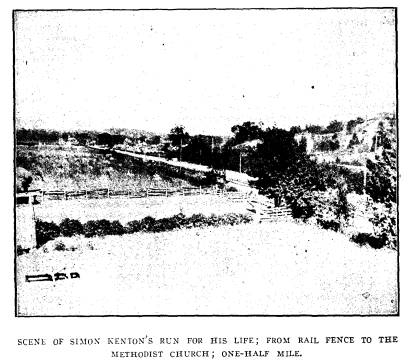Ohio History Journal
KENTON'S GAUNTLET
AT CHILLICOTHE.
T. J. BROWN, WAYNESVILLE, OHIO.
The question of the identity of Old
Town, near Xenia, with
the "Chillicothe" where Kenton
ran the gauntlet the first time,
has been thoroughly discussed in
previous issues of the QUAR-
TERLY, and in my opinion the evidence in favor of it is decidedly
satisfactory.
Prof. McFarland's testimony seems
conclusive of itself, while
the traditions bearing upon the question
reach back to the earliest
settlement of that locality and
practically amount to authentic
history.
Tecumseh's home at that time was but a
few miles north,
at old Piqua, or Pickaway, on Mad River.
He may have been
present on this occasion, or at least he
most likely assisted in
Kenton's reception at Piqua, as he
passed through on his way
north, during which journey, as history
says, he ran the gaunt-
let eight times; but the first time,
that at Chillicothe, seems to
have been the most celebrated. Perhaps
the fame of the desper-
ate strength and prowess he exhibited on
that occasion preceded
him, and there was not such a general
turnout of women and
children as at Chillicothe, and even the
warriors themselves may
have been somewhat shy of coming in
close touch with him, so
that all "gauntlets" but the
first may not have been so hotly
contested.
We are told that the women were always
among the most
active participants on occasions of the
kind, and that he wrested
a club from the hands of one of them
during his famous race,
which assisted him very materially in
clearing a path to the goal,
and by that means securing a temporary
reprieve.
After the destruction of Chillicothe and
Piqua, it is likely
Tecumseh's home was in Miami county, at
the Indian village
established by the refugees from the
villages on the Little Miami
and Mad river, but he was a frequent
visitor among the early
(483)
|
484 Ohio Arch. and Hist. Society Publications. white settlers at Old Town, and there is no doubt the Galloways and others received truthful information from him and from other sources. The earliest roads of the white man followed Indian trails. Detroit street, running north and south through Xenia, got its name from a traders' trail to Detroit, which it followed. This trail was doubtless an Indian trail, adopted by the whites and |
|
|
|
developed into a road. It is now a well graded and graveled turnpike from Xenia to Old Town, and beyond. According to well authenticated tradition, the Indian coun- cil house stood where now stands the Methodist church at Old Town, and Kenton began the race for his life, or rather for a reprieve, at the foot of the hill just to the right, in the picture, followed the line of the pike and ended at the council house-a |
Kenton's Gauntlet at
Chillicothe. 485
distance of about half a mile. The
property adjoining the road
is now owned by Miss Helen Boyd, of
Xenia.
A large tract of prairie reached from
the village east to the
low hills, and south for miles. All that
space from the council
house to the beginning of the race
course must have been free
from obstructions at that time, and
afforded the hundreds of
participants an excellent field for the
exercise of their skill and
activity.
I am indebted for the picture primarily
to the good offices of
Mr. Clark McKay, of Xenia, who secured
the able services of
Mr. Frank Baily, also of Xenia, as
artist.
